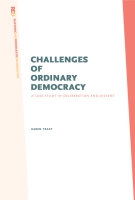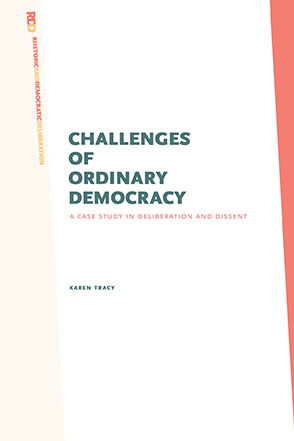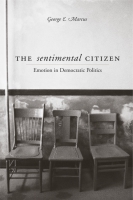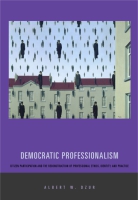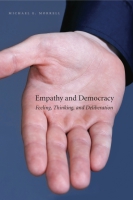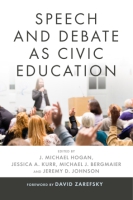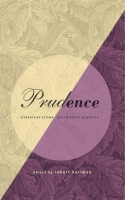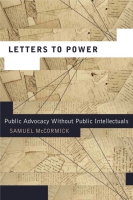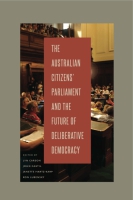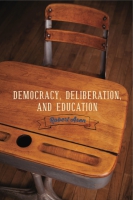Challenges of Ordinary Democracy
A Case Study in Deliberation and Dissent
Karen Tracy
“In Challenges of Ordinary Democracy, Karen Tracy draws us close to the workings of self-government in modern America. There, we can see the balance that must be struck between deliberative norms of civility and the emotional power of dissent and grievance. Tracy’s provocative idea of ‘reasonable hostility’ as a model for effective local politics will stir controversy, but she will certainly have stimulated more grounded thinking about the complex interactions of officeholders and citizens in free societies.”
- Description
- Reviews
- Bio
- Table of Contents
- Sample Chapters
- Subjects
“In Challenges of Ordinary Democracy, Karen Tracy draws us close to the workings of self-government in modern America. There, we can see the balance that must be struck between deliberative norms of civility and the emotional power of dissent and grievance. Tracy’s provocative idea of ‘reasonable hostility’ as a model for effective local politics will stir controversy, but she will certainly have stimulated more grounded thinking about the complex interactions of officeholders and citizens in free societies.”
“When we lament the current state of political discourse, we almost always have in mind Washington, D.C., where party platforms, platitudes, and posturing too often substitute for genuine, meaningful debate. In this valuable book, Karen Tracy reminds us that ‘ordinary democracy’ happens in some fifteen thousand school boards around the country. In these local institutions and others like them, verbal and written exchanges among board members, union officials, parents, the media, and the interested citizenry substantially bear upon the kinds of education that children ultimately receive.”
“The phrase ‘ordinary democracy’ will forever be remembered because of this scholarly and painstakingly researched case study of the Boulder Valley School District. Using the board meeting minutes, interviews, transcripts, and cable and local news media as her ‘text,’ Tracy analyzes how local democracy and democratic values are used for good and ill. The role of communication, in all of its forms, both contributes to and undermines the ordinary democracy being played out by the quintessentially American enterprise—the local board of education. One comes away being forever grateful that democracy still does exist in communities across the country because of local school board governance.”
“Karen Tracy provides what students of democracy have long needed: a sophisticated, detailed analysis of democracy in practice that bridges the worlds of theory and criticism. Tracy recounts the struggles and triumphs of citizens as they tackle the challenges of ordinary democracy. Anyone who wants to understand the workings of democracy—its promises and pitfalls—ought to read this book.”
“This finely observed account of a highly controversial three years in the Boulder Valley (Colorado) School District is a great resource for anyone who wants to understand the forms of democracy in which citizens themselves have a say. These feisty, conflictual moments, sometimes sparked by a newspaper intent on provoking controversy, pose significant challenges for practitioners of local democracy and scholars of deliberation. The method is worthy of emulation and the theory original and provocative.”
“The well-written stories in this refreshing book demonstrate that participation and deliberation scholars, lately much focused on extraordinary democratic experiments, can learn a great deal from researching sites of ordinary democracy.”
“Karen Tracy’s perceptive analysis stays at the ground level; ‘ordinary’ means ‘local’ and ‘observable’ speech that reflects routine concerns--speech that aims to do a solid day’s work in the public world. . . . Her central goal is simply to describe and make sense of the ordinary democratic talk of local government, something as understudied as it is celebrated in political theory. . . . Challenges of Ordinary Democracy posits ‘reasonable hostility’ as the appropriate communicative ideal for local deliberative forums such as school board meetings. . . . Passionate expressions of dissent are to be expected in functioning democratic politics, Tracy concludes, rather than avoided and neutralized. In advocating realism over idealism and by paying close attention to details, Tracy rightly directs those interested in understanding contemporary democracy to the sometimes messy everyday practices in the unassuming places all around us.”
Karen Tracy is Professor of Communication at the University of Colorado, Boulder.
Contents
List of Figures and Tables
Acknowledgments
1. Public Meetings: Ordinary Democracy’s Home
2. A Historical Snapshot: Three Years of BVSD Life
3. “Democracy”: An Ideal with Traction
4. Citizen Participation, Doing Dissent
5. Newspapers in the Cycle of Political Upheaval
6. The Campaign: The Usefulness of Platitudes and Personal Attack
7. A Fight over Words and Policy
8. One Meeting: Six Observations
9. Reasonable Hostility in Ordinary Democracy
Postscript: Education Governance in Twenty-First-Century America
Appendix: The Method and Data
References
Index
Public Meetings
Ordinary Democracy’s Home
In a large room in a school district’s administration building, the bimonthly public meeting of the school board has begun. It is the last meeting before the winter holidays. The room is packed, and citizens are lined up to speak. An ad in the local newspaper criticizing the board’s actions, signed by 450 community members, has appeared several days earlier. Parents, teachers, and other community members are upset; each person wants his or her two minutes of public participation time. The president of the teachers’ union comes to the lectern.
I would like to read part of a statement tonight. That statement was first read by Board president Stephanie Hult on November 9, 1995. I quote, “this board will be supportive of and respectful of teachers and their talents, of variety in teaching in methods, in variety of educational philosophies. We want to create a climate of openness, freedom, and goodwill. This will not be a time of dismantling, but of building. Not of destroying but of creating.” I praised those words on that evening. I praise them tonight. But something has gone seriously wrong in the intervening months.
The teachers’ union president is interrupted by applause. Other speakers who criticize the board are also applauded, but those who express support hear boos. Following a round of angry murmurs, the board president rebukes the audience for its incivility. The room quiets briefly, but soon the applause and murmurs resume. A lively, contentious school board meeting has begun, and ordinary democracy is under way.
Public meetings in which elected officials gather with their citizens, superintendents, and high-ranking school staff to talk with one another, after which the elected officials will vote on matters, are a staple of U.S. democracy. “Voting after speaking,” Frank Bryan notes, “is to governance what keeping the score is to sports. It changes everything. But it is in the speaking, the direct face-to-face link between talk and power, that real democracy transcends nearly every other definition of democracy issued since the Greeks.” Bryan was writing about New England town meetings in which all who attended voted, but the importance of talk before voting is equally crucial in representative governance bodies. In meetings of representative groups, talk occurs among elected officials, between officials and citizens, and between officials and staff. All three kinds of exchanges affect the decisions that are made. Depending on who does the talking, where it occurs, and who the listeners are, this talk has different names—participation, discussion, a work session, communications, a hearing, deliberation, debate. Through these varied types of meeting talk, the ideals of democracy that animate American life touch down and become actual practices. Admittedly, the concrete expression of democracy is imperfect, never more than a flawed enactment of an ideal. Even so, democracy on the ground is remarkable. Providing a rich description of public meeting talk in one community, as its citizens and elected officials engaged in “ordinary democracy,” is my first purpose in this book.
The book’s second purpose is to put forward a communicative ideal for school board meetings that takes account of the multiple competing aims that are, and should be, part of ordinary democracy. “Ideals and standards formed without regard to the means by which they are to be achieved and incarnated in flesh,” John Dewey commented, “are bound to be thin and wavering.” Reasonable hostility, the communicative ideal I advocate, honors several competing and legitimate aims that are alive in sites of ordinary democracy. Reasonable hostility, I will show, not only occurs regularly in education governance meetings but is an ideal that can be defended as desirable.
Ordinary democracy is the name I give to the communicative practices that occur in local governance groups. The concept refers to what actually happens in groups committed to acting democratically. Two features of ordinary democracy deserve mention. First, ordinary democracy emphasizes the local, prototypically school boards and city councils. Second, ordinary democracy is observable. It is not a normative ideal; it can be seen and heard. When governance groups meet, ordinary democracy is what they are doing. The communicative practices governance groups use will be affected by ideals of what it means to act democratically that permeate American public life. At the same time, ordinary democracy is shaped by a host of individual- and group-level purposes. It reflects the routine concerns of those who plan meetings, of citizens who attend and speak, and of members of the public who read the news and watch the cable broadcast. Ordinary democracy includes communicative actions that uphold the ideal of democracy, and it includes actions that challenge, appeal to, and subvert that ideal. Democracy is a vision, not an actual practice, noted John Gastil. Ordinary democracy is what happens. Its home is the public meeting.
In coining the term ordinary democracy, I join the company of other sociopolitical commentators who define a kind of democracy and seek to distinguish it from other forms. “Representative” and “direct” democracy are straightforwardly descriptive terms—conditions that either do or do not apply in particular settings. By far, though, the larger category for terms invokes counterfactual ideals laced with powerful sentiment. We have, for instance, deliberative democracy, participatory democracy, discursive democracy, unitary democracy, strong democracy, and communicative democracy. Often these ideals are contrasted with specific, less satisfactory versions of democracy, as is seen in Benjamin Barber’s influential ideas about thin versus strong democracy and Iris Marion Young’s aggregative versus communicative democracy. My purpose in this book is not to sort through these subtly different views. Others have done so ably. Rather, I would highlight how each of these is a normative concept that articulates a picture of what democracy should be like—the communicative and institutional conditions that must be present if that type of democracy is to be judged as existing.
Ordinary democracy, by contrast, begins with existing institutions and describes what is occurring in them. School boards are one site of ordinary democracy. Although theorists disagree about how to define democracy, almost everyone agrees that school board meetings are places where it should be happening. “In the public mind,” Samuel Bacharach notes, “the local school district has been viewed as the embodiment of democratic values.”
As an idea, ordinary democracy is most like Bryan’s concept of “real democracy.” Real democracy, as Bryan defined it, is what occurs in local-level direct democracy groups, such as town meetings. Ordinary democracy is what occurs in local-level representative governance groups. With the exception of the New England states, direct democracy as a governance format has virtually disappeared in the United States. Nevertheless, it continues to play an important role in the American story about democracy. Perhaps, as Bryan contends, direct democracy is more “real,” a better icon of what is important about U.S. democracy. But most local communities use representative governance, not direct democracy. Thus, ordinary democracy is about what happens in the most commonly occurring local governance format. Ordinary democracy, like real democracy, is an empirically anchored concept. Both views of democracy begin by describing what governance groups do, but their focus differs. Bryan’s real democracy emphasizes participant profiles (e.g., percentages of male/female attendees and speakers), the variation in meeting structures (e.g., morning vs. evening meetings, bundling of town with school business, or not), and voting patterns. Ordinary democracy emphasizes talk. Focusing on the content, style, and structures of talk that citizens and elected officials use as they meet and make decisions in their public meetings, ordinary democracy is about communicative conduct.
In a paper on public deliberation in the Unites States titled “A Nation That (Sometimes) Likes to Talk,” John Gastil and William Keith show how the valuing of deliberative talk in models of democracy waxed and waned in the twentieth century. In the first thirty or so years of the century, and then starting again in the late 1960s, talk was assumed to be important to democracy’s well-being. Benjamin Barber eloquently captures the promise of a talk-rich conception of democracy: “talk remains central to politics, which would ossify completely without its creativity, its variety, its openness and flexibility, its inventiveness, its capacity for discovery, its subtlety and complexity, its eloquence, its potential for empathy and affective expression, and its deeply paradoxical (some would say dialectical) character that displays man’s full nature as a purposive, interdependent, and active being.”
Talk is regularly celebrated as central to democratic life, but rarely is it examined carefully. What does the talk of public meetings sound like? What is the character of its arguments and sentiments? How are delicate, potentially threatening activities accomplished? Do citizens and officials use different communicative styles? How are disagreements brought out and managed in meetings? How do sustained, side-taking conflicts affect later meeting activities? In what ways do discussions during the early part of a meeting shape how officials subsequently vote and explain their vote? How does discussion in the larger public sphere—for example, in newspaper articles, editorials, and letters to the editor—shape what happens in meetings?
People who argue that politics is about action often precede the noun “talk” with such belittling modifiers as “mere,” “only,” or “just,” implying that talk is trivial, undeserving of serious attention. Not true. The First Amendment enshrines a distinction between speech and action, but, as has long been recognized, speech is action. Words transform worlds. Through talk, people make, resist, and change policies; cement or endanger relationships; and sooth or intensify conflicts. Through the cumulative impact of a group’s talk, institutions thrive or collapse. Through talk, people strengthen the practice of democracy—or destabilize and weaken it.
“Yes,” you might say, “talk is important. I’ll grant you that, but it’s not the public meeting talk that matters, it’s what goes on in back rooms and in side conversations. The talk that occurs in public meetings is a performance, the ratification of decisions that were talked into being elsewhere.” Such a view captures many Americans’ view of public meetings, especially those held by state and federal agencies that regulate risk-related utilities such as nuclear energy. The fear of private conversations and of deals being struck in back rooms, in fact, has prompted most states to pass “sunshine laws” that, to varying degrees, limit the type and amount of talking that officials can do outside the public eye. Decisions in local governance sites increasingly must to be made in public meetings with limited or no private prior conversations.
Talk is not the only thing that shapes a decision. Elected officials come with predispositions toward issues and often will have committed themselves to those predispositions publicly during political campaigns. They also will have read packets of “information” prepared by a governance group’s staff, and for issues that are controversial they are likely to have been inundated with telephone calls and e-mail messages. Decision-making processes are complex, and they include multiple sources of legitimate input about issues. Even so, talk matters. Public meeting talk shapes eventual decisions, and the manner in which citizens and officials go about their talking is a powerful emblem of democracy. Public meetings are democracy’s litmus test. Is a governance group’s “democracy” healthy and thriving or seriously ailing?
School boards are but one of the several different types of local governance groups. City councils, county governments, and township organizations are in fact more numerous. School districts made up roughly one-sixth of the 87,525 local governance units in the 2002 census of governments. Although all forms of local governance deserve more detailed study, the need to examine school boards is especially pressing. To be fair, many specialists in education have researched schools as educational organizations and have examined how superintendents manage relations with their teachers, boards, and communities. In addition, books about how to be a good school board member have appeared regularly since citizens first started serving in these roles. But studies of school boards as sites of democratic governance and politics are relatively rare. In one of the few such books that exist, political scientist William Howell observes, “It is hardly an exaggeration to note that more is known about the operation of medieval merchant guilds than about the institutions that govern contemporary school districts.” My goal in this book is to draw attention to the school boards that so ably motivate citizens to attend public meetings and speak out.
Public schools in American society are treated as “the panacea for social ills and the chief vehicle for individuals’ upward mobility.” Nothing gets people off their couches faster than the perception that a proposed action in their local schools will harm their offspring. Because of its close connection to people’s own children and morally contestable symbols, educational decision making is emotional and volatile. “Of the issues regularly featured prominently on the local political stage,” David Campbell notes, “school politics is often the star of the show. Americans care deeply about their local public schools.”
“Education” is not an easily delimited issue; it is best conceived as a gloss for a messy tangle of concerns about children, schools, learning, civic conduct, money, and moral issues. Educational issues are the routine fare of school board meetings. Only the endangering of freedom or justice trumps Americans’ concerns about public education. So said President James Garfield many years ago, and I would suggest that this is equally true today.
How have school boards evolved into such hot spots of democratic governance?
A Brief History of U.S. School Boards
School board controversies abound in contemporary America. A Lexis Nexus search of major newspapers for the words “school board” over a one-week period returned 210 hits. Expanding the search to cover a year and pairing “school board” with terms that indicate problems yielded many more hits: “trouble” (90 hits), “controversy” (151 hits), “conflict” (194 hits), “problem” (474 hits). June 2007 ended with a 5-4 U.S. Supreme Court decision to limit the use of race in integration plans. “With competing blocs of justices claiming the mantle of Brown v. Board of Education,” proclaimed the New York Times, “a bitterly divided Supreme Court declared Thursday that public school systems cannot seek to achieve or maintain integration though measures that take explicit account of a student’s race.” With the Court’s decision, school segregation resumed center stage as an especially problematic issue. Newspapers around the country identified the implications for their local communities. “Flawed Judgment: Supreme Court Majority’s Blindness to School Segregation Will Undercut Efforts to Fix It,” announced the Houston Chronicle. “Civil Rights Struggle Lives on in LA’s Public Schools: Segregation Rising Since Mid-1980s,” said the New Orleans Times-Picayune. “High Court Ruling on Race May Echo in Hub Schools,” the Boston Herald warned.
A huge number of diverse issues generate controversy. Examples from the past couple of years include (1) debates about intelligent design, (2) a district’s policy about what plays could be produced, which followed a student-written production with a gay antagonist, (3) a civil suit charging violation of a state’s open meeting law, (4) a conflict over whether an elected or an appointed board was the real governing authority, (5) disputes about how boards and superintendents were conducting themselves, and (6) disagreement about whether Al Gore’s film about global warming, An Inconvenient Truth, should be treated as controversial material that required the presentation of an opposing side.
In a survey of two thousand school districts prepared for the National School Boards Association, Frederick Hess begins, “Lay governance of public education is a uniquely American institution with roots in the locally controlled schools of the New England colonies and in the common school movement of the mid-19th century.” In contrast to most European countries, where education is a service similar to mental health and administrative decisions are made by professional experts, educational decision making in the United States follows a hybrid form. On the one hand, education is an arena of democratic governance that is taken for granted; decisions are expected to reflect the will of a community. On the other hand, operating schools is seen as an activity that should be left to education professionals, with the district superintendent understood to be the leader. How this hybrid character is understood—how much weight is given to these two competing assumptions—depends on participants’ positions in a school district. In a 1992 survey, 62 percent of parents and other community members thought they should have a major say in the allocation of school funding and decisions about the curriculum. By contrast, only 15 percent of school administrators and 26 percent of teachers held that opinion.
Beyond the competing assumptions about whether educational issues are matters of democratic governance or areas for professional expertise, there is an additional tangle: money—and the right to have a say that goes with it. Funding of education has become increasingly complicated, with a smaller proportion generated at the local level. In 1920, 83 percent of school district funding came from the local community, with the federal government contributing less than 1 percent. In 2000, only 43 percent of school district funding was generated at the local level, with 50 percent coming from the state and 7 percent from the federal government.
During the nation’s early years, decisions about schools were made entirely at the local level, and as late as 1850 half of school financing was private. For most of the nineteenth century and the early years of the twentieth, secondary education was available primarily through private and parochial schools. As secondary education became more widespread and commonplace, the number of school districts decreased dramatically. Before 1900, the number of school districts in the United States was estimated at 160,000. By 1936, the first year for which we have reliable data, the number had fallen to slightly fewer than 119,000. By 1972 the number of districts was down to 15,780, a number that has decreased only slightly since then. In 2002 the U.S. census of governments reported 15,014 school districts. As school districts consolidated, the number of students they served increased and the number of board members making the decisions decreased. In 1936, for instance, the average school district served 218 students. By 1997 that average had climbed to 3,005 students. The average number of members on a school board reflected the opposite trend. In 1893, large urban school boards averaged twenty-two members, but by 1913 the average had dropped to seven, a number that has remained consistent to the present day.
Educational matters were the first domain in which woman were allowed to vote in public bodies. In the half-century preceding the 1920 ratification of the Nineteenth Amendment, giving women the right to vote, a few states allowed women to vote on school questions. Presumably, making decisions in matters of education was a reasonable extension of women’s roles as teachers and mothers. Only in the 1970s, however, did the percentage of female board members exceed 12 percent. By the 1980s women made up 33 percent of school board members, and by 2002 that number had risen to 39 percent, with large school districts (those with more than twenty-five thousand students) reporting somewhat higher percentages than small districts. The racial composition of boards today is also affected by district size, with bigger districts having a larger percentage of African Americans and Latinos. In large districts an average of 21 percent of school board members are African American or Latino. Across districts of all sizes, the average is 14 percent.
School districts have some of the same governance rights as city councils, townships, and county governance bodies. Most important, they regularly make decisions about taxes, usually without needing approval from municipal governments. Because they are independent units of government, they are exempt from many municipality-specific regulations. At the same time, school districts, and the boards that run them, differ in significant ways from municipal governments. Unlike other local units, school districts are agents of the state, exercising their power on behalf of the state. States can mandate how elections will be conducted in local school districts, as occurred when the state of Texas mandated that school board elections be changed from at large to ward based. The binding of school district and state works in the opposite direction as well: A 1993 court decision required that the state of California bail out a local school district that was going to close six weeks early because of insufficient funds.
A key feature of school board positions, as compared to state and federal offices, is their “localness.” Localness involves many things. One particularly important aspect is the communicative demands it puts on elected officials. The onerous character of these demands is well captured in a complaint made by a school board president.
Many a time I’ve thought, “God, it’s got to be great to be a senator or something.” You’ve got all these layers to protect you from members of the public that aren’t happy with what—what’s going on. Who have this particular issue that they want or ax that they want to grind with you. Uh, whereas here you have no layers to protect you. You’re next-door neighbors. You’re at the same dry cleaner with everybody else. It’s—there is a localness to it. And an immediacy of access. And an expectation that you’re always going to be accessible that’s just unduplicated, I think, in—in American politics anywhere else.
School governance practices across states exhibit little uniformity. Fifty-four different governance structures are legally recognized. School boards vary in terms of whether members are elected, appointed, or some combination of both. If members are elected, districts vary as to whether elections are partisan or nonpartisan and whether they are conducted at large or within wards. Although there is a lot of diversity in terms of structure, one format is strongly preferred. Most boards (93 percent) elect all of their members, and the vast majority hold nonpartisan elections in which candidates run at large rather than in wards. In addition, most board positions are either unpaid or come with a small token salary. In only 3.4 percent of districts, mostly the largest ones, do board members receive salaries of even as much as $10,000 annually.
An “apolitical” philosophy, with roots in the Progressive Era, shaped the design of school board elections. “Progressives argued that there was ‘no Democratic or Republican way to pave a road’ or run a school and sought to drain any partisan fever from the electoral process.” To ensure that school governance was as apolitical as possible, elections were made nonpartisan, and school board elections were often held on a different day from national and state elections. Although this practice began to shift in the late twentieth century, as of 2002 only 47 percent of school districts held elections on the same day as national and state elections.
Through the first half of the twentieth century, school governance was understood as a forum in which wise elders met and made judgments about the needs of their community. “The community” was presumed to exist as a unitary entity with a single set of interests that could be perceived by elected officials talking together and then making decisions by consensus. Board members were considered trustees of the public good, and although it was never completely adopted, “the ideology of rational deliberation, application of technical information, and consensus building” was the reigning rationale. A view of the school district as a place of unitary democracy was taken for granted as the decision-making framework until the 1950s. With the landmark case of Brown v. Board of Education (1954), which banned school segregation, the belief that school governance was or could be apolitical was shattered.
By the 1970s school districts were recognized as places in which groups with competing interests could battle it out. Legislation passed in the 1970s, such as Title IX, provided citizens with tools for bringing lawsuits to remedy perceived inequities. In addition to competing interests among community groups divided by race, ethnicity, and gender, an additional group—teachers—became especially prominent in political battles. By the 1980s, with the exception of southern states, teachers in virtually all U.S. school districts were unionized. As a result, teachers’ unions became key players in educational politics. In addition, political conservatives sought to bring about political change by running for office at the local level, and school boards were one key venue in which to effect change.
Since the 1950s school boards have increasingly become places of conflict. A 1992 survey of school board members found that most characterized their boards as having frequent conflicts. In a manual designed to help new school board members master their roles, William Hayes identified a list of divisive issues that incoming board members could anticipate, among them school choice, standards testing, site-based management, and policies on school violence, religion, sexual orientation, academic tracking, language education, and employee compensation. In twenty-first-century America, no one would argue that school governance can escape politics. But compared to other local governance groups, a stronger unitary democratic ethos continues to pervade education decision making. Alongside the adversarial, interest-based model of governance presumed to be in operation, there is an equally strong belief that school boards should attend to the needs of “the community,” usually understood as a single body. The assumed relevance of these contradictory views of “democracy” is but one situational feature that makes the doing of ordinary democracy in education governance so challenging.
Analyzing meeting talk can help us understand how ordinary democracy is enacted in education governance, and the examination of more than a handful of meetings is needed. After a political battle that some individuals and groups have lost, it is crucially important to look at how a school board and its community attend to ruptured relationships. If no attention is given to rebuilding relationships, or if it is done in a problematic way, future decision making is likely to be affected. As Danielle Allen has argued, “The real project of democracy is neither to perfect agreement nor to find some proxy for it, but to maximize agreement while also attending to its remainders: disagreement, disappointment, resentment, and all the other byproducts of political loss.” To understand ordinary democracy, we need to investigate how school boards make decisions and how they attend to their decisions’ remainders.
The Case: Board Meetings in the BVSD, 1996–1999
This book is a case study of three years’ worth of board meetings of the Boulder Valley school district (BVSD), one of Colorado’s larger school districts and one of several nestled at the base of the Rockies’ front range. My analysis focuses on communication in and surrounding the public meetings held during thirty-five months (April 1996 through February 1999) of a particularly explosive period in the district’s history.
In 1990 I moved to Boulder to join the faculty of the University of Colorado’s Communication Department and became a typical Boulder citizen, someone who called Boulder home without having grown up there. My daughter was beginning first grade at the time. She spent her elementary school years in the public school around the corner from our house. My involvement in the schools was limited: I attended school performances and parent-teacher conferences, and helped with an occasional classroom activity or trip, but I was not involved in school or district governance. Not long after my daughter entered middle school, the local newspaper began to be filled with letters to the editor, editorials, and news stories about the school board. Many of the controversies that were occurring focused on communicative conduct—who was or was not acting “democratically.”
The 1995 election had brought two new members to the BVSD board committed to changing the status quo. These two were philosophically aligned with two members already on the board. The four people constituted a majority, and they began to implement changes. One of these changes involved broadcasting the bimonthly public board meetings on a local cable TV channel. Along with others in the community, I began to tune in and watch the board meetings. I also began taping them. As a communication scholar who studies institutional talk, I was fascinated by the conflicts being played out. I was sure there would be something worth writing about, although at the start I had little idea what that something would be. I had initially decided to stop collecting data at the end of the 1997–98 school year, but when a controversy over sexual orientation erupted in the fall of 1998, I extended the time frame. My taping of board meetings stopped in February 1999, following the board’s vote on the district’s strategic plan, the policy document in which a short section about sexual orientation had occupied the board’s attention for six months (see chapter 7).
My daughter had by now entered high school. She was “hating school” and not doing well, and at the start of tenth grade we transferred her from the large public high school to a small alternative school. The irony of the situation did not escape me, nor did a certain amount of guilt. Here I was, a person committed to public education, yet I was buying out of the public school system. I did what many parents cannot: I left the public schools when I saw that they were not meeting my child’s needs.
“Public education” and the slew of equity, quality, and symbolic issues it raises pit a range of socially valued goods against each other. When finances are limited, decisions cannot be other than trade-offs among more or less reasonable proposals. I make no claim to be completely neutral in narrating the BVSD’s controversies, but I was not involved in any of the groups that formed. My role was that of a peripheral, albeit opinionated and invested, observer. At different times I felt sympathetic toward or critical of almost every BVSD participant, as well as of the different opinion blocs that came into being. Consider the structure of the typical BVSD meeting during this time.
The governance format of the BVSD is similar to that of many school boards around the United States. It is, in fact, the most commonly occurring kind. Board members are chosen in at-large nonpartisan elections to serve in unpaid positions. The board comprises seven members serving four-year terms, with half elected every two years. Rather than move around the district and meet in different locations, one common practice, the BVSD board uses another common practice, meeting in the school district’s administrative building. During 1996–1999, BVSD board meetings were broadcast over a local cable channel, and copies of the videotaped meetings were stored in the local library and were available for public borrowing.
The Boulder Valley school district is relatively large. In his survey for the National School Boards Association, Hess classified districts of fewer than 5,000 students as small, those with 5,000–24,999 students as medium, and those with 25,000 or more as large. At the time, slightly more than 25,000 students attended the BVSD’s fifty-plus schools. The district includes roughly a quarter of a million people spanning nine communities that include a variety of small suburban cities, tiny mountain towns, and the university-based city for which the district is named. At the meetings that took place during this study, board members typically sat on an elevated dais that faced a lectern where the public presenters stood, while the superintendent and the district attorney sat at a table adjacent to the dais. On the other side of the dais was a staff person who took minutes, called the roll, and rang the bell marking citizens’ speaking time limits. The room also had several tables toward the front where district administrators or invited experts would sit when they presented information. Rows of chairs facing the dais provided seating for the public.
Meetings began with a roll call of board members and the pledge of allegiance. Then, up to twenty-five citizens could speak for two minutes each on any item that was not on that meeting’s agenda. The superintendent then gave a report, and board members made remarks about issues they wished to comment upon that were not on the agenda. After these events the group turned to the business of its posted agenda, discussing, and sometimes voting on, specific issues. BVSD policy required that every issue, with the exception of “consent agenda” items, be discussed in at least one meeting prior to the one in which a vote was taken. Consent agendas included a large variety of items deemed routine and noncontroversial. The items on a consent agenda were voted on as a set, although an item could be removed at the request of a board member. On agenda items, up to ten citizens could speak before the board began discussion.
Board meetings during 1996–1999 often lasted more than five hours, beginning around 7:00 P.M. and going past midnight. Table 1.1 summarizes these data under two board presidents. Besides taping and taking notes on the BVSD public meetings, I transcribed roughly sixty hours of meeting talk. In addition, I collected meeting agendas and minutes, newspaper articles, letters to the editor, and editorials. I also conducted interviews with board members, a superintendent and several district staff, the education reporter and the editor of the local newspaper, and the two people who during this time served as dean of education at the nearby University of Colorado, where many district teachers had received their degrees. Finally, to develop a sense of what aspects of BVSD board meetings were typical versus unusual, I observed board meetings in seven other districts and examined board minutes—available on the Internet—from a variety of school districts. The appendix provides details about data and methods.
Discourse Analysis
Discourse analysis, the primary method I use in this book, is used by scholars in different fields but especially in linguistics, sociology, and communication. Discourse analysis begins by audio- or videotaping communication situations and then making a written record that preserves specifics of how people talk. In interview or quantitative coding studies, researchers commonly clean up the segments they transcribe. Features of talk that are judged not to contribute to the speaker’s main point are eliminated; transcripts usually eliminate “uhs” and “ums,” broken-off words, restarts, repairs, and passages that a researcher deems repetitious. Discourse analysts do not edit in this way. Analysts like me consider these small, regularly occurring features of talk important. We use these little bits of talk as one resource with which to build arguments about a situation’s communicative meanings. Table 1.2 explains the conventions I use to represent people’s speech, its context, and how I draw attention to specific words and phrases.
A cut-off phrase, for instance, might provide evidence of a range of interesting social sensitivities. For example, a parent at one BVSD board meeting complained about the district’s decision to pull his daughter’s project from her elementary school’s annual science fair. The school had informed him that his daughter’s project violated the district’s nondiscrimination policy. The third-grader had shown thirty adults and thirty fifth-graders Barbie dolls of two races, black and white, in dresses of two colors, and had asked them to indicate which doll was prettier. Although all of the adults picked the doll in the purple dress, most of the children in this almost entirely white elementary school picked the white doll. In his emotional speech to the board, the father said of his daughter’s findings, “it’s not a terribly surprising result, and in my view not a terrib—not necessarily a racist one either.” The father’s revision of “not terribly racist” to “not necessarily racist” was significant. If we ask what this particular repair accomplished, we perceive a citizen working hard to present himself as nonracist. It is not okay for a project to be merely “not terribly racist.” This small repair, I suggest, reflects the father’s recognition of this social fact and reveals his in-the-moment attempt to prevent others from viewing him negatively. To paraphrase Harvey Sacks, the father of conversation analysis, close scrutiny of talk enables the discovery of facts about people and the social world that could never have been imagined.
For readers unfamiliar with discourse-analytic studies, I offer a caution. When a written record is made of speech, there are many repairs, repetitions, and so on. This is true of even the most articulate speakers. These conversational perturbations are ordinary features of talk, a normal part of speaking. In everyday talk they tend to fly by unnoticed. A transcript makes them visible. In interpreting transcripts, readers need consciously to apply a “talk frame” to what they read. Talk is an activity in which people edit and fix as they go. It is not writing. To be sure, talk in public meetings is more preplanned than talk in everyday conversation. Nevertheless, public meetings are moments of talk.
Overview of the Book
To understand communicative moments in BVSD board meetings and make judgments about what is (or is not) reasonable in ordinary democracy requires an understanding of the larger social scene. Chapter 2 provides this context and some analysis of the social scene. The focus is on the period between 1996 and 1999, but important earlier events are also described. “Schools take shape in response to the ideological and practical demands of the society of which they are a part,” remarked Roald Campbell. Chapter 2 provides a sense of what those demands were and introduces the key players in BVSD board meetings.
Chapter 3 begins the analysis of BVSD meeting talk. In this chapter I examine the instances in which the term “democracy” surfaced in participant remarks and identify the kinds of actions the references accomplished. Participants used the term to criticize others, justify their own actions, and advocate specific future actions. This chapter also considers how democracy is invoked without explicit use of the term. Focusing on three especially contentious meetings, I show how contrary belief sets about democracy are brought to life, including contradictory views about the character of rules in democracy, the role of elected officials, and whether the meeting was a forum for unitary or adversary democracy.
What does citizen participation in a school board meeting look like? Chapter 4 addresses this question at three levels. The chapter’s first part provides an overview. I then focus on BVSD minutes from ten meetings to see how citizen remarks and actions were represented. Finally, I analyze 101 speeches from three meetings, attending especially to the strategies citizens used to express negative sentiment. The chapter closes with reflections about the meaning of high and low levels of participation.
In Chapter 5, I show how the local newspaper heightened and substantively shaped incipient conflicts in the district. In an ethnographic study of activist and volunteer groups in the United States, Nina Eliasoph argues that newspaper coverage of local events is part of a cycle that feeds Americans’ political apathy. I provide evidence that the opposite was true in Boulder Valley during this time. Focusing on several meetings that occurred shortly after a series of articles and editorials about results of the first wave of standardized test scores appeared in the newspaper, I show how newspapers can become agents of political agitation as easily as instruments of apathy.
Chapter 6 focuses on the 1997 election, which broke spending records for a BVSD board campaign. In the campaign, which quickly became a competition between two slates, the central issue was whether the incumbents were conducting themselves respectfully and reasonably. After narrating the campaign’s main events, I analyze a televised debate in which the seven candidates participated and show that candidates used platitudes—banal expressions of positive sentiment—as conversational devices to attack opponents indirectly. In contrast, the newspaper’s campaign ads, guest opinion pieces, and letters to the editor were direct and unmitigated personal attacks. In chapter 6, I show that platitudes and personal attacks, usually considered negative, can serve socially desirable ends.
In chapter 7, I examine the six-month debate on the district’s diversity policy, a controversy that came to be about whether the BVSD was going to “respect” or “value” its gay students. Wrangles over language and the crafting of an institution’s policies are different sides of a single coin. In this chapter I describe the diversity controversy’s unfolding and the different ways in which BVSD participants approached the wording of the proposed document. Arguing about words, I show, offers local governance bodies a way to manage a group dilemma.
The board meeting of January 14, 1999, was one of the last in the thirty-five-month period. In chapter 8, I analyze this meeting and formulate six conclusions about school board meetings and the workings of ordinary democracy. Drawing on this meeting and on interviews with board members, I show that (1) majority members are constrained in ways that minority members are not; (2) ordinary democracy includes ongoing conflicts about what should be on the agenda; (3) board member “discussion” is a matter of giving speeches; (4) the amount of sunshine in public meetings affects how people talk; (5) democratic deliberation during board meetings involves speakers drawing on, responding to, and disagreeing with the newspaper; and (6) characterizing a particular communicative act as a personal attack is a positioned evaluation, not a description.
In chapter 9, I summarize what the BVSD case reveals about the discourse practices and challenges of ordinary democracy. Communicative practices described in earlier chapters—speaking in platitudes, personal attacks, negative campaigning, nitpicking about words, confronting others with their undemocratic behavior—are obvious signs that a governing body is experiencing difficulties. At the same time, these practices serve valuable ends. They are reasonable responses to democracy’s challenges. In conclusion, I argue that theorizing about deliberative democracy, a tradition grounded in a normative ideal expected to apply across situations, has had an unintended negative effect on ordinary democracy. The workings of local school boards need a communicative ideal that takes account of the multiple aims and competing values that are always present in sites of educational governance. Reasonable hostility, a kind of criticism that marries argument and emotion, is just such an ideal. If democracy is to thrive, then, in moments of conflicting interests, reasonable hostility will be a necessary and valuable norm for communicative conduct.
In the postscript I place the 1996–99 BVSD case study in the context of education governance a decade later, showing how study of this above-average school district during a period ten years earlier has implications for communication practices in education governance in twenty-first-century America.
Mailing List
Subscribe to our mailing list and be notified about new titles, journals and catalogs.
